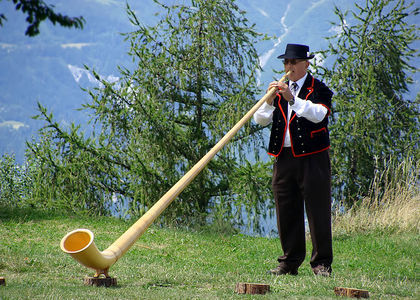> Recommendations

The Music of the Mountains, Pastoral Music (I). The Alps and the Carpathians on the Traditional Styles of Music Programme on 9th February
The Alps and the Carpathians, two mountain ranges, the symbols of our European civilisation
Starting with the edition on 9th February, 2016, on the Traditional Styles of Music programme, you will be able to listen to a new series dedicated to mountainous ... musical landscapes that will include its importance in the development of the ancient and long-lasting European cultures, based on the people's cohabitation shielded by the rough and natural "fortresses" of the mountains. The traditional cultures in the Alps and the Carpathians have many similar characteristics, such as, sheep breeding and the ancient pastoral land activities inherited by the native populations from their ancestors who lived in those regions. A common landmark is alternative sheep herding, namely, the migrating of the herds up into the mountains at the beginning of the summer season and their moving onto the lower plains at the beginning of autumn. Either they happen in the Swiss and Austrian alpine meadows, or in the Carpathians's pastures, these pastoral activities bear the obvious imprint of an ancient world, of ancient origins, rooted in a complex series of traditions and customs.
Pastoral musical instruments
Another similarity (from ethnomusicological perspective, which is the guiding line of our programme) lies in the use of large aerophone musical instruments with diverse purposes and functions, that is, from signaling to large distances down to integrating them into magic ritual functions, and, why not, even into the entartaining ones. All these instruments, we are talking about, are included in the labrophone family; they emit sounds by produsing air vibrations within a long wooden tube. The structure of the melody articulated by these instruments cannot create varied compositions, so they are simple songs based on the sounds called "natural harmonics". There are numerous instances that emphasise the melodious and expressive qualities of the instruments included in the labrophone family, from the sounds played both on the 'bucium' in Bucovina and the 'tulnic' used in the Apuseni mountains, to the sonorities of the 'Waldtuter', instrument specific to South Tyrol, and, last but not least, down to the resonances of a Swiss 'alpenhorn'.
Jodler Songs
Jodler songs are very popular musical creations representative for the musical traditions in the Alps' cultural space. They can be interpreted both individually and in groups, both vocally and instrumentally. Jodler songs are spectacular compositions, based on melodic constructions in which the musical scales (normally, the tonal value scales with their two important functions, the tonic and the dominant ones) support the entire sonorous edifice 'enriched' and ornated with high pitch guttural sounds, seemingly freed from the constraints of the melodic lines, and rigurously framed by the scarcity of the musical piece. Thus, we could compare it to the 'long circle dance' in Maramureș and the 'neck circle dance' in Lăpuș, musical genres that you had the chance to enjoy, on numerous occasions, within the Traditional Styles of Music programme.
Therefore, on Tuesday, 9thFebruary, 2016, starting at 20:30, on Radio Romania Music or on the website: romania-muzical.ro, I invite you to listen live to the first edition within the series of programmes dedicated to pastoral and alpine music, that will take us on a journey around the Carpathians and the Alps, with diverse, exciting and interesting sonorities.
Translated by Elena Daniela Radu
MTTLC, the University of Bucharest














